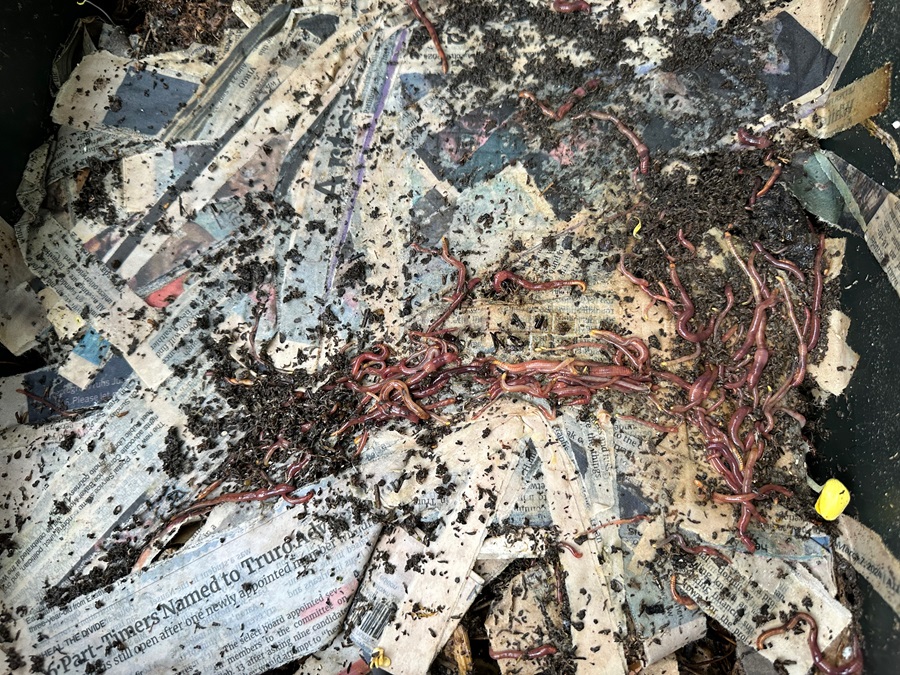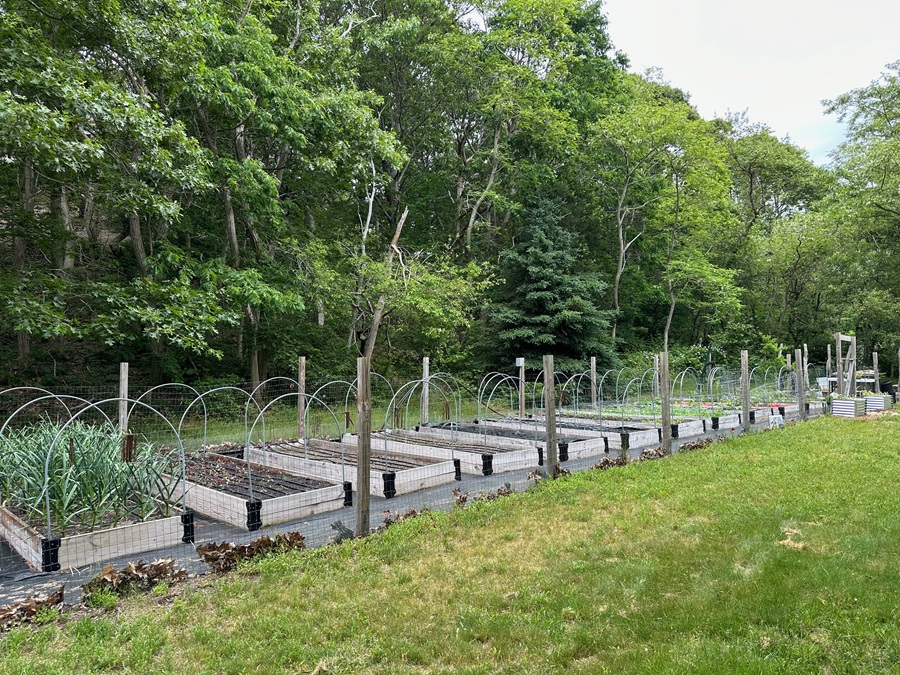A trio of plastic bins occupies a shady corner of a parcel of land in Truro where Jole Bell rents three garden plots from Meryl Gartside, the owner of Blue Lobster Flower Farm. The multi-story containers are home to Bell’s red wigglers. They’re not her pets — the wigglers are essential to the health of Bell’s garden. She practices vermicomposting: using earthworms to make compost.
Regular compost is a soil amendment made of organic material like food scraps and garden trimmings. Vermicomposting adds a step to the process: the worms eat the organic material and then poop it out as castings rich in nutrients like calcium, nitrogen, and phosphorus. In this way, “earthworms and microorganisms join forces in a bio-oxidation and stabilization process that does not have a thermophilic stage,” writes Grace Gershuny in her 2011 book Compost, Vermicompost, and Compost Tea.
What she means is: the worms speed up the composting. You don’t have to turn the pile or wait for it to heat up, because the worms’ digestive process and wriggling take care of that for you.

Though native to Europe, red wigglers (Eisenia fetida) have become naturalized across the United States. A pamphlet on vermicomposting put out by the Mass. Dept. of Environmental Protection lists red worms as the best kind for this purpose — they thrive in decomposing matter and are “efficient processors,” eating and expelling their own weight every day.
A starter bag of 250 red worms from Uncle Jim’s Worm Farm, where Bell bought her worm towers, is advertised on its website for $29.95. She didn’t have to buy any worms, though. Four years ago, a family friend in Brewster gave Bell a small container of them. They’re prolific reproducers: fertilized eggs take three weeks to hatch; in three months, those worms begin breeding. All of Bell’s worms are descendants of that first handful.
Bell’s worm tower is made up of three six-inch-tall plastic bins that can be unstacked for easy access. On the top tray, she places shredded old newspapers and food scraps straight from the kitchen. Removing the top tray, she reveals a second tray lined with strips of damp newspaper “courtesy of the Provincetown Independent,” Bell says, which makes a nice bed (and a bedtime snack) for the worms. Over the newspaper is another layer of kitchen scraps of assorted crushed eggshells, vegetable stalks, and clumps of castings, which look like soil.
But the bottom bin is “where the worms are actually doing all the work,” Bell says. That’s where “the real thick, solid compost” is made. Here, the worms have turned the paper and food scraps into dark, rich dirt. This is what Bell will spread across her garden. This bottom tray has a hole in one of its sides through which “compost tea” drips into a waiting bucket below.
The entire system trickles down through little holes in the bottom of each bin. The worms also squeeze through the holes as they travel between the bins to reach their desired destinations. The whole thing is very self-sufficient, Bell says. At their most active — when temperatures are between 55 and 77 degrees Fahrenheit, her worms will go through two pounds of kitchen scraps every two or three days.

Bell grew up in Artesia, N.Mex., where her family has had a cattle ranch since 1890. She lives there in the winter, when the worms are near-dormant, at least when left outdoors in the cold. In the summer, she lives in Truro, where she takes care of these rather smaller livestock.
“Farming is farming,” Bell says.
Without the resulting castings — which are sometimes called “black gold” by gardeners — “we would probably have a bug problem in the garden,” Bell says. She doesn’t have grubs or other insects, “probably because it smells to them of worms.”
Though humans find the worm castings emit only an earthy, pleasant smell, the worm poo certainly seems to repel pests: according to a 2021 article on vermicompost in Agronomy for Sustainable Development, vermicasts help growers manage tomato hornworms, cabbage white caterpillars, cucumber beetles, aphids, spider mites, and mealy bugs.
For several small trees around the property, two cups of compost tea per year does the trick. For a recently transplanted blueberry bush at the edge of the yard, half a gallon of tea and a tray full of vermicompost per year is perfect. Bell has “100 percent” noticed a positive change in her garden, she says, since she started tending worms. And “fertilizers are getting more expensive,” she adds. “The more we can make ourselves, the better.”

You may not want to keep your worms indoors, according to Sabine Heinlein, who wrote “Let Me Tell You About My Worm Farm” for the New York Times Wirecutter last year. Though she said her wigglers were quiet roommates, Heinlein soon found that they were escaping their enclosure to roam her apartment. “A few days in,” she wrote, “we’d find wigglers that had died on their way down the stairs. We accidentally stepped on them while brushing our teeth. Once, I even felt the crunch of a desiccated worm corpse as I put on one of my sneakers. It made me sad.”
Keeping your wigglers outside can be risky, too, for different reasons. When this reporter visited Bell’s worm towers, she was in the middle of setting up noisemakers to ward off curious raccoons. Cold weather also poses a threat. This year, her worms had a hard winter outside in their towers. There were some casualties.
Peering into one of the towers’ second level, Bell begins to dig through the scraps and castings with a gardening spade. A worm pokes its petal-pink head out of a dirt-clod. “She lives!” Bell says. She picks up the tray and holds it in the air for a look at the holes. The rear end — or is it the front end? — of a red wiggler pokes through one of them and reaches around lethargically. “Wake up,” Bell says gently. In the lumpy material of that second tray, a few more worms slowly push past newsprint and eggshells. “They look happy,” she says.
Is she attached to the red wigglers in any sentimental way? “No,” Bell says. But she really digs their product.



